Tong W. Wind Power Generation and Wind Turbine Design
Подождите немного. Документ загружается.

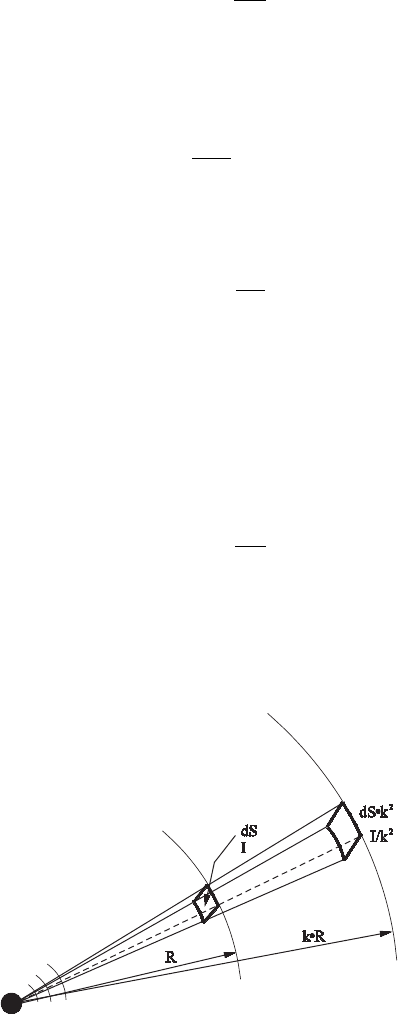
Wind Turbine Acoustics 155
2
p
2
ref
'
10 log
p
L
p
⎛⎞
=×
⎜⎟
⎝⎠
( 3)
where the reference pressure is p
−
5
= 2 × 10
5
Pa. The sound pressure level can be
expressed also in terms of the sound intensity, which is defi ned as the sound power
transmitted through unit area and far from the source can be written as
2
00
'p
I
cr
=
(4)
where r
0
and c
0
are the undisturbed air density and sound speed, respectively. Thus
the sound pressure level can be written as
p
ref
10 log
I
L
I
⎛⎞
=×
⎜⎟
⎝⎠
(5 )
where the reference sound intensity is I
ref
= 10
− 12
W/m
2
. To characterize the total
power of a sound source, one has to integrate the sound intensity over a closed
surface surrounding the source
d
S
PIS=
∫
( 6 )
Similarly to the sound pressure level, one can defi ne the sound power level as
p
ref
10 log
P
L
P
⎛⎞
=×
⎜⎟
⎝⎠
(7 )
where the reference power level is P
ref
= 10
− 12
W. Thus for a point source with
spherical wave spreading the sound intensity at a distance kR is I / k
2
, I being the
sound intensity at a distance R from the source (see Fig. 1 ). It is important to note,
that the sound power level, L
w
, is a characteristic of the sound source, it refl ects
Figure 1: Illustration of sound intensity.
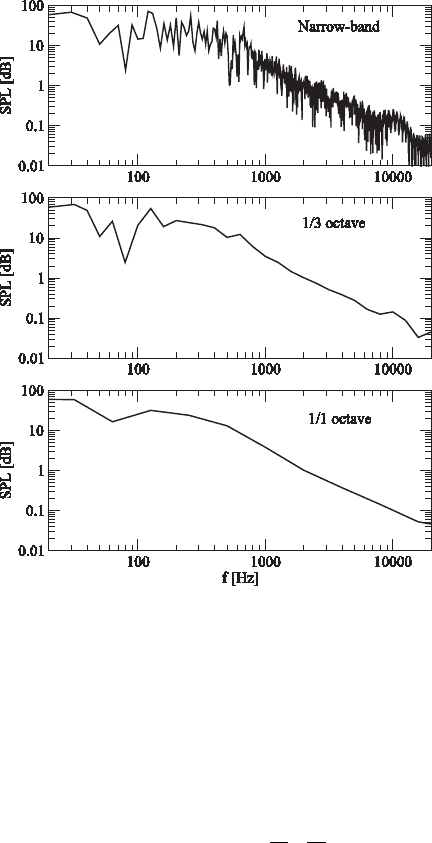
156 Wind Power Generation and Wind Turbine Design
the amount of acoustic energy generated by the source. In contrary, the sound pres-
sure level, L
p
depends on the observer position and quantifi es the amount of sound
energy reaching the observer.
Pure tones are rarely found in practice, most devices emit sound composed by a
set of different frequencies:
'( , ) cos 2
ii
i
xt
ptx A
T
p
l
⎡⎤
⎛⎞
=±
⎢⎥
⎜⎟
⎝⎠
⎣⎦
∑
(8 )
Thus, the frequency spectrum of the acoustic pressure has to be determined as
well to characterize the sound. There are three types of commonly used spectra:
narrowband, 1/3 octave band and 1/1 octave band. In this context band refers to a
given frequency interval over which the amplitudes are averaged. For an octave band
the upper limiting frequency is exactly the double of the lower limiting frequency.
For a 1/3 octave band the ratio of the upper and lower limiting frequencies is 2
1/3
.
For a narrow-band frequency the width of the bands is constant and ‘small’ enough
to capture pure tones and thus gives the most details about the spectrum. Figure 2
Figure 2: Narrowband (top), 1/3 octave band (middle) and 1/1 octave band
(bottom) spectra of the same acoustic pressure signal.
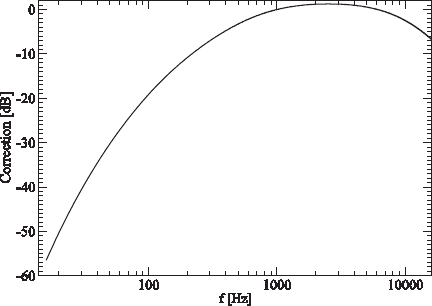
Wind Turbine Acoustics 157
shows examples of narrowband, 1/3 octave band and 1/1 octave band spectra of the
same acoustic pressure signal.
Human ear is sensitive to sound in a range of about 20 − 30 Hz and up to 20 kHz.
This range varies among individuals and changes in time with reduction of the
range with age. Additionally, the sensitivity is frequency-dependent. For sounds
with frequencies of the order of 3 − 4 kHz the sensitivity is the highest, the thresh-
old of hearing being around 0 dB, while at low frequencies it might be required
a sound pressure level of 40 dB to be heard [ 4 ]. To account for this uneven sen-
sitivity of the ear, weighted sound pressure/sound power levels have been intro-
duced, the most commonly used being the A-weighted sound pressure level,
computed as
[][][]
pA p A
dB( ) dB dBLAL L=+
(9)
where the weighting function varies as it is shown in Fig. 3 . A-weighting is suitable
for most applications. In cases where low-frequency noise is dominant, B or C weight-
ing might be more appropriate. These weightings are similar to the A-weighting,
just the shape of the weighting curve is different.
4 Wind turbine noise
Acoustic studies involve three main stages: sound generation, propagation and
reception (see Fig. 4 ). In the case of wind turbines there are several different
kinds of noise sources which are discussed in Section 4.1. The generated noise
is propagating through the air, this propagation being infl uenced by the air prop-
erties, the landscape, vegetation, presence of different obstacles, etc. These
issues are discussed in Section 4.2. The third stage is the sound immission, i.e.
the perception of the sound at an observer position. Beside the sound pressure
level there are other parameters as well which infl uence the perception of the
Figure 3: A-weighting function.
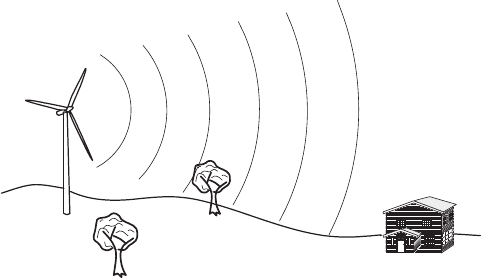
158 Wind Power Generation and Wind Turbine Design
sound as acceptable or annoying. Details about these parameters are given in
Section 4.3.
4.1 Generation
There are two main categories of wind turbine noise sources: mechanical and
aerodynamic.
4.1.1 Mechanical noise
The mechanical noise is generated by the machinery in the nacelle. The main noise
source is the gearbox, but important contributions are coming from the generator
also [ 5 ]. The cooling fans and the other auxiliary devices contribute to a lower
extent to the total noise.
Depending on the transmission path, the mechanically generated noise can be
divided in two main categories (see Fig. 5 ). When the noise is directly radiated
in the atmosphere it is called air-borne , like the noise emitted by the gearbox
through the nacelle openings. Another part of the mechanical noise is due to
vibrations propagated through the transmission elements and fi ttings to the
nacelle casing and tower leg. This indirect noise is called structure-borne . The
structure-borne gearbox noise constitutes the main contribution to the mechanical
noise [ 5 ].
The noise and vibrations in the gearbox are due to the transmission error of the
meshing gears. The transmission error is the difference between the desired and
the actual position of the driven gear. Thus a more accurate production of the gear-
box leads to lower noise levels. There are also differences among different gear
types, helical teeth are less noisy than the spur ones. Also, epicyclic gearboxes are
usually noisier, one of the gears being directly mounted on the casing. Due to the
wear of the gears the amplitude of the generated vibrations increases with time.
A doubling of the transmission error leads to an increase of approximately 6 dB in
the noise level.
Figure 4: Illustration of sound propagation.
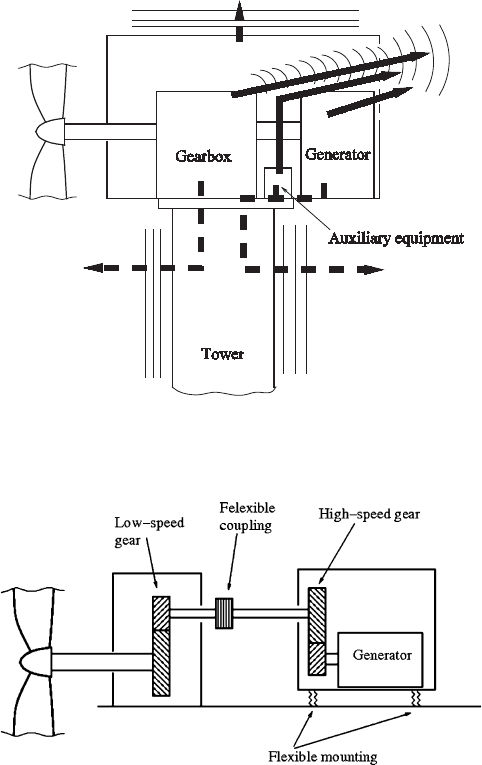
Wind Turbine Acoustics 159
To reduce the gearbox noise, proper teeth profi les and high accuracy products
are needed. To avoid amplifi cation of the noise by the casing, the casing has to be
designed to have eigenfrequencies far from the critical frequencies from the gears.
To avoid the transmission of vibrations, elastic couplings have to be used between
the mechanical devices. For large turbines, such couplings cannot transfer the
torque and the elastic coupling is mounted between the low-speed and the high-
speed stages of the gearbox. This approach is effi cient, since most of the noise is
coming from the high-speed gears, which can be elastically mounted using this
solution (see Fig. 6 ) [ 5 ]. Further reductions of the emitted noise levels can be
achieved by acoustic insulation of the nacelle.
Figure 5: Mechanical noise sources: air-borne noise (continuous arrows) and
structure-borne (dashed arrows).
Figure 6: Mechanical noise reduction using elastic fi ttings (after [ 5 ]).
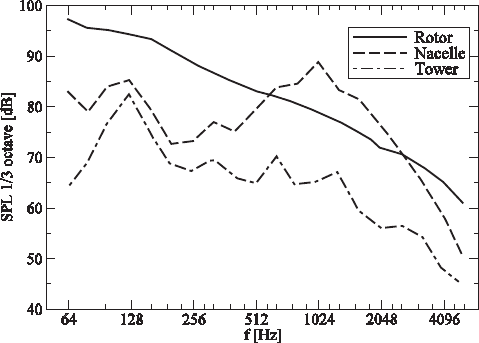
160 Wind Power Generation and Wind Turbine Design
Figure 7 shows typical 1/3 octave band spectra for a small 75 kW wind turbine
measured by Ohlrich (cited in [ 5 ]). One can observe that the aerodynamic noise
due to the rotor blades is dominating in almost all frequency bands, except around
1 kHz where the mechanical noise originating from the nacelle prevails. Also, the
mechanical noise spectra from the nacelle and tower is more tonal, while the rotor
noise is ‘smoother,’ it has a more broadband character.
As a conclusion, there are effi cient ways to reduce the mechanical noise. Since
mechanical noise is not increasing that fast with increasing turbine size like the
aerodynamic noise [ 6 ], the current research is mainly focused on the reduction of
the aerodynamic component of the wind turbine noise.
4.1.2 Aerodynamic noise
Early theoretical studies of wind turbine noise were based on analogies with acoustic
studies of semi-infi nite half-planes which were symbolizing elements of the rotor
blade [ 7 , 8 ]. Later the studies were based on results from non-rotating airfoil noise.
Lowson [ 9 ] divided the wind turbine noise sources in the following categories:
discrete frequency noise at the blade passing frequency and its harmonics •
self-induced noise sources •
– trailing edge noise
– separation-stall noise
– tip vortex formation noise
– boundary layer vortex shedding noise
– trailing edge bluntness vortex shedding noise
noise due to turbulent infl ow •
The fi rst group of noise sources contains low-frequency components due to the
uneven loading of the blades due to wakes, large-scale structures or velocity
gradients in the atmospheric boundary layer.
Figure 7: Typical frequency spectra from a wind turbine (after [ 5 ]).
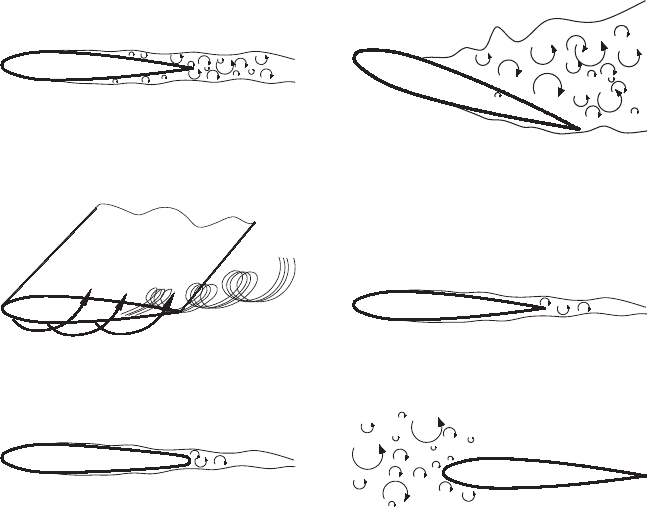
Wind Turbine Acoustics 161
The second group includes the noise sources generated by the airfoil itself, thus
present even in a perfectly homogeneous infl ow. The trailing edge noise ( Fig. 8a )
is due to the interaction of the turbulent eddies generated in the boundary layer and
the trailing edge of the airfoil. The turbulent eddies themselves are relatively weak
sources, but their effect is amplifi ed when they are in the vicinity of a plate (in this
case the trailing edge) [ 8 ]. Separation-stall noise ( Fig. 8b ) occurs when the angle
of attack is too large and the fl ow separates. In such cases the separation-stall noise
dominates the other noise sources [ 4 ]. At the tip of the blade a vortex is formed due
to the pressure difference at the pressure and suction sides. The pressure fl uctua-
tions due to the presence of this vortex generate the tip vortex formation noise
( Fig. 8c ). The boundary layer vortex shedding noise ( Fig. 8d ) occurs when bound-
ary layer instabilities develop along the airfoil. Such instabilities might lead to
separation and the appearance of Tollmien Schlichting waves. While the trailing
edge noise has a broadband character, the boundary layer vortex shedding noise is
tonal. Trailing edge bluntness vortex shedding noise appears when the thickness of
the trailing edge exceeds a critical limit, dependent on the Reynolds number and the
shape of the airfoil ( Fig. 8e ). When this critical limit is exceeded a Karman-type
vortex-street develops giving rise to a tonal noise.
The third group includes noise due to atmospheric turbulence. Due to the fl uc-
tuations in the incoming air stream, the blades suffer an unsteady loading, giving
(a) Trailing edge noise (b) Separation stall noise
(c) Tip-vortex noise
(d) Boundary-layer vortex
shedding noise
(e) Trailing edge bluntness noise (f) Noise due to turbulent inflow
Figure 8: Noise generation mechanisms for an airfoil.
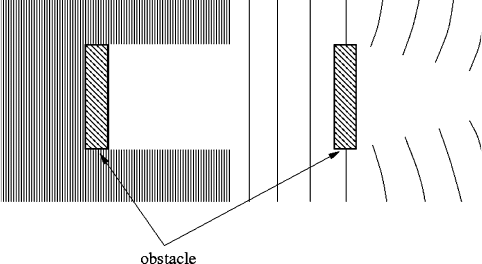
162 Wind Power Generation and Wind Turbine Design
rise to noise ( Fig. 8f ). One commonly divides the noise due to atmospheric
turbulence into a low-frequency regime (when the length-scale of the fl uctuations
is much larger than the size of the body) and a high frequency regime (the length-
scale of the fl uctuations is much smaller then the airfoil). As it will be shown in
Section 6.2, these two regimes can be treated separately in noise modeling [ 4 ].
Due to the chaotic behavior of turbulence, these models are not deterministic.
According to Lowson [ 9 ], the self-noise sources dominate at low wind speeds,
near cut-in, while at the rated power the turbulence inlet noise source dominates.
A detailed description of all these noise mechanisms can be found, e.g. in [ 4 ].
4.2 Propagation
In the previous section the noise generation mechanisms have been discussed. The
knowledge of these noise sources , however, is not enough to predict the sound
pressure level at a receiver. While the acoustic waves are traveling through the
atmosphere, several factors infl uence the propagated sound pressure levels, the
most important ones being the followings:
The • distance to the receiver. For increasing distance the acoustic energy is
spread in a larger volume which decreases the sound pressure level.
• Absorption is due to the air viscosity and converts the acoustic energy into heat.
• Refl ections due to the ground and surrounding objects.
When a wave passes around a solid object • diffraction occurs. For high frequen-
cies (wavelength much smaller than the object size) a shadow zone occurs
behind the object. The shadow zone decreases with decreasing frequency, com-
pletely disappearing for wavelengths much larger than the size of the object
(see Fig. 9 ).
• Refractions are caused due to temperature gradients which cause different
densities in different layers of the air, and as a consequence impose different
propagation speeds of the sound waves.
The • wind speed and direction infl uences the directivity of the noise propagation.
Figure 9: Diffraction behind obstacles high-frequency (left) and low-frequency
(right) waves.
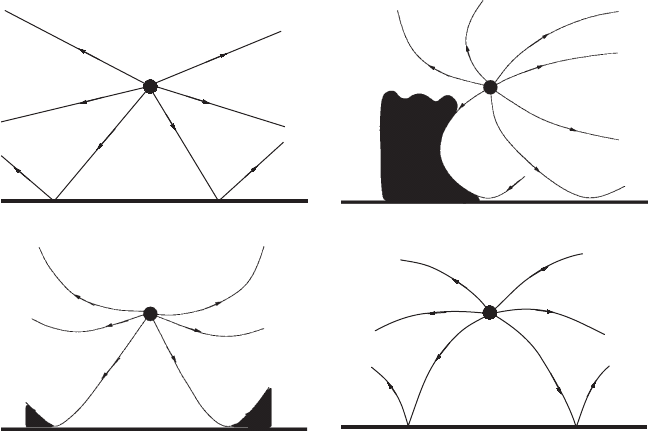
Wind Turbine Acoustics 163
The infl uences of the last two parameters are visualized in Fig. 10 . If there
would be no wind and no temperature gradients, the sound waves would propa-
gate along straight lines ( Fig. 10a ). In windy conditions the noise propagation
paths are curved towards the wind direction ( Fig. 10b ). Negative temperature
gradients cause lower temperature regions at higher altitude, thus lower propa-
gation speeds for the noise. As a result, the noise propagation paths will be
curved upwards ( Fig. 10c ) (the opposite effect happening for positive pressure
gradients, Fig. 10d ). One can observe in Fig. 10 that in certain conditions shadow
zones appear where the noise will not propagate.
Compared to other industrial noise sources, wind turbines have two main spe-
cial features [ 5 ]. First, the sources are located at an elevated level which leads to
reduced screening and ground attenuation effects. Secondly, in windy conditions
sound propagation is diffi cult to predict.
4.3 Immission
There are several factors infl uencing the level of annoyance from wind turbine
noise [ 6 ]. Both the odds of perceiving the wind turbine noise and the odds of being
annoyed by wind turbine noise increases with increasing sound pressure level [ 10 ].
Pedersen and Larsman [ 11 ] showed that the visual impact is important when wind
(a)
(b)
(c)
(d)
Figure 10: The infl uence of vertical temperature gradient and wind speed on noise
propagation: (a) no wind, no temperature gradient; (b) wind from left
to right, no temperature gradient; (c) no wind, negative temperature
gradient; (d) no wind, positive temperature gradient.
164 Wind Power Generation and Wind Turbine Design
turbine noise is evaluated. When wind turbines are considered as ugly struc-
tures being in contrast with the surroundings, the probability of annoyance by
the noise increases, regardless of the measured sound pressure levels. Even if
the visual impact is not considered, the annoyance of the noise with the same
equivalent sound pressure level can be rated differently. Waye and Öhrström
[ 12 ] exposed several persons to noise registered from different wind turbine
types, scaled to 40 dB L
eq
( A ). The differences in annoyance response could not
be explained by the psycho-acoustic parameters considered (sharpness, loud-
ness, roughness, fl uctuation strength and modulation). In regions with high
background noise levels the wind turbine noise is considered less disturbing
[ 6 , 13 ]. Thus the acceptance level of wind turbines is higher in regions with
large traffi c, industrial areas or where a lot of noise is generated by vegeta-
tion or waves, while it is signifi cantly lower in recreational and rural areas. For
the same reason, wind turbine noise is considered more disturbing during the
night than during the day. As it is emphasized by Grauthoff [ 14 ], not only the
audible levels are important, high infrasound (below 16 Hz) levels might also be
percepted as annoying.
4.4 Wind turbine noise regulations
A recent survey of noise regulations in several countries is presented by Pedersen
[ 6 ]. Since it is considered unneeded to present all the details for the specifi c coun-
tries, here we summarize the major strategies adopted in the legislations. There are
three different kinds of noise limitation strategies:
1. Fixed values . As an example, in Sweden the highest recommended sound
pressure level originating from wind turbines is set to 40 dB, with a penalty of
5 dB for pure tones. Although this strategy is straightforward to apply it is the
least fl exible. In quiet areas even noise with sound pressure level correspond-
ing to the 40 dB limit might lead to the annoyance of the people. Contrarily,
in regions with high background noise levels even higher wind turbine noise
levels would be accepted and a fi xed value of the limit leads to suboptimal
power production.
2. Relative values . Wind turbine noise limits in Great Britain recommend a maxi-
mum noise emission of 5 dB above the background noise levels. This approach
is much more fl exible, but diffi cult to implement practically.
3. Variable values . In the Netherlands, the maximum limits of the emitted noise
vary as function of the wind speed. This method is more fl exible than the fi rst
one and easier to implement than the second one. Nevertheless, there are fur-
ther issues to be solved. Depending on the atmospheric stability conditions,
the wind speed measured at a fi xed height above the ground might not be an
accurate indicator of the wind speed met by the rotor blades. Van den Berg
[ 15 ] presents an example where the practically emitted sound pressure levels
exceeded the ones predicted with ‘standard’ methods because of the higher
velocities at rotor height than predicted.
